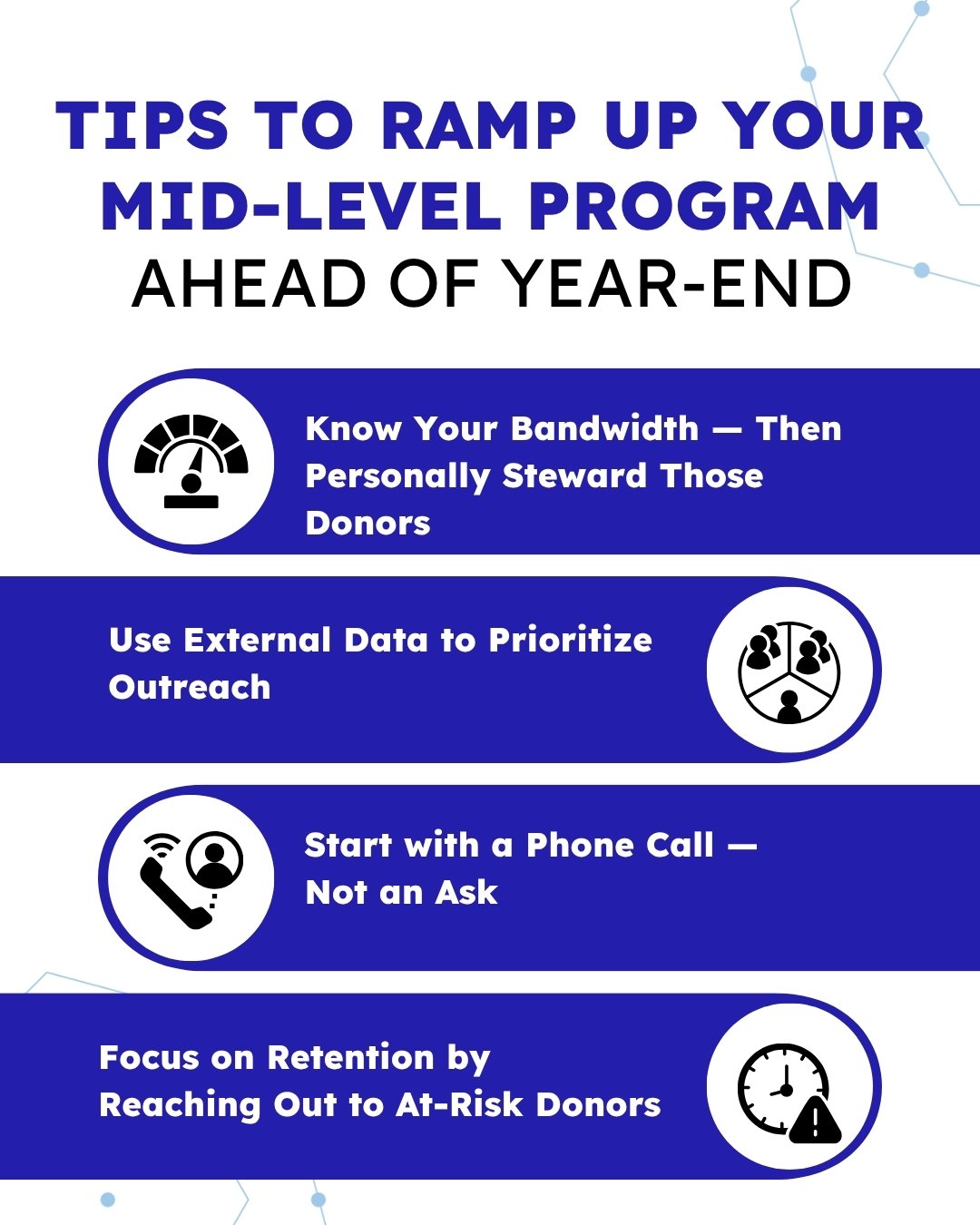4 Tips to Ramp Up Your Mid-Level Program Ahead of Year-End

As the year-end approaches, your mid-level donors represent one of your most valuable, and often under-leveraged, segments. These supporters are primed for deeper engagement, larger gifts, and long-term loyalty.
Mid-level donors make up one of the most strategic areas of growth opportunities for nonprofits, but they often fail to receive the tailored attention they need. Capitalizing on this opportunity takes intentionality, personalization, and a thoughtful approach – not just the same one-size-fits-all message.
Remember, these donors may account for as much as 50 percent of your revenue and often give more than a third of the money you raise. In fact, two-thirds of major donors started in mid-level giving. These loyal donors offer significant lifetime value, so don’t wait any longer to act.
With thoughtful engagement now, you can deepen relationships, boost retention, and generate surprise gifts that close out the year on a high note. Here are four tips to help you activate your mid-level strategy.

Tip 1: Know Your Bandwidth — Then Personally Steward Those Donors
Why it matters: Not every mid-level donor requires the same level of attention. Your team should focus on quality over quantity.
Mid-level donors may have different preferences for their engagement experience. Depending on the number of mid-level donors, it may not be feasible for your organization to provide an identical experience to everyone. Additionally, segmenting engagement strategies and experiences by donation amounts can encourage higher levels of giving.
What to do:
- Determine how many mid-level donors you (or your team) can realistically manage in a personal way.
- Build the list and commit to cultivating those relationships through consistent, meaningful outreach. Ensure that you create a level of stewardship that your team can maintain; otherwise, you risk fatigue and burnout.
- Prioritize authentic stewardship and relationship-building. A direct ask isn’t the goal of these personal touchpoints and can sometimes have a negative effect. Strengthen the connection now, and you may see an increase in giving when it’s time for the next ask.
Tip 2: Use External Data to Prioritize Outreach
Why it matters: Many mid-level programs miss opportunities because they treat all donors the same. To identify those most likely to give more — and engage more deeply — you need to go beyond gift amount. Use data to segment your list based on giving history, engagement behavior, and capacity to give.
What to do:
Focus your energy on donors who are most likely to upgrade — whether through a year-end campaign or a surprise major gift. This is a key strategy for organizations with small teams and limited bandwidth.
Enrich your donor file with third-party data or tools that assess wealth, giving behavior, and affinity. AGP’s GivingDNA platform, for example, can help you identify and prioritize those donors with mid-level potential.
The Middle Matters for Year-End.
Tip 3: Start with a Phone Call — Not an Ask
Why it matters: Human connection cuts through the noise, especially at year-end when inboxes and mailboxes are flooded. According to AGP research, mid-level donors want to be treated like people, not an ATM. They expect personalization, recognition, and relevance.
Organizations that act by taking small, consistent actions achieve higher retention, greater lifetime value, deeper engagement, and improved visibility into effective strategies.
What to do:
- Call first — before sending any other form of outreach.
- Let them know you’re reaching out with gratitude, updates, and a desire to understand what inspires their giving. Remember, it’s about them, not your organization.
- If you don’t have a phone number, a heartfelt, handwritten note with your contact information can still create a strong personal touch. Ask members of your board or volunteers to help out.
Tip 4: Focus on Retention by Reaching Out to At-Risk Donors
Why it matters: Mid-level donors who lapse are harder (and more expensive) to win back than those you retain now. Inaction on a mid-level strategy is costing you time, money, and donors. If donors don’t hear from you, they may doubt the impact of their gift or your alignment with their values. Lack of communication fosters uncertainty and eventual disengagement.
Waiting to act is costly.
What to do:
- Each month between now and the end of the year, identify mid-level donors who are at risk of lapsing.
- Send a personal email with updates on the impact their support has had, but avoid generic language. Tailor the content. If you don’t have their email address, pick up the phone to share an update via a quick call.
- These updates often spark unsolicited gifts and responses, strengthening both your retention and revenue.
Your mid-level donors are more than just a revenue stream — they’re your future major donors, your most loyal advocates, and the heart of your year-end success . As you approach year-end, your mid-level donors are uniquely positioned to make a meaningful difference. They’ve already demonstrated their commitment to your mission with their gifts, and with the right touchpoints, they’re often willing to give again — and give more.
Unlike new or lapsed donors, they don’t need to be convinced of your value; they just need to be inspired and engaged. That makes them one of the most efficient and high-potential groups to focus on as the calendar winds down. Don’t keep them waiting.
Unlock the potential of your mid-level donors with our tiered accelerator program

Ryan Carpenter, VP of Client Success at AGP, brings diverse experience in fundraising, from Mid-Level giving to data analytics. From agencies (THD) to nonprofits (Year Up) and software (GivingDNA), he excels at crafting data-driven strategies to identify, cultivate, and solicit donors. His talent lies in untangling complex data to find hidden trends and develop multi-channel engagement tactics that strengthen donor relationships and unlock major gift potential.